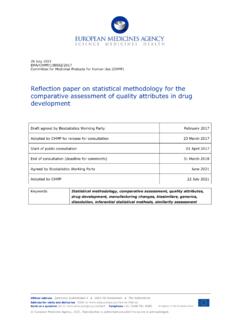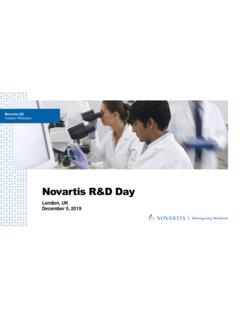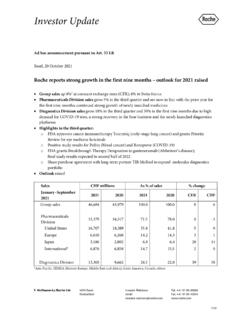Transcription of The Role of Coding in the Development of the …
1 The Role of Coding in the Development of the Biosimilar market : Considerations for Policymakers July 2015. THE MORAN COMPANY. 1. The Role of Coding in the Development of the Biosimilar market : Considerations for Policymakers As the first biosimilars make their way to market in the United Sates based on the Food and Drug Administration's (FDA) implementation of the Biologics Price Competition and Innovation Act of 2009 (BPCIA),1 the Centers for Medicare & Medicaid Services (CMS) also has an important role to play in the Development of the biosimilar marketplace. CMS has recently proposed a policy under which all biosimilars with a common reference biologic would be placed into a single code for billing and The Moran Company was asked by our client, Hospira, to consider the potential economic impact of such a decision on the biosimilar marketplace.
2 In order to reach a conclusion on this question, we reviewed relevant literature, focusing particularly on competition among generic drugs, since biosimilar competition is relatively new. We also conducted an analysis of the impact on pricing of analogous Coding situations to shed light on the potential impact of the CMS policy. Statement of the Policy Question With its recent Proposed Rule and other discussion,3 CMS has begun the process of determining how biosimilars will be reimbursed in the Medicare program, which we expect will influence the formation of the market . The agency characterizes its decision to put all biosimilars for a common reference biologic into a single HCPCS code as similar to the ASP calculation for multiple source drugs.
3 4 This characterization ignores a fundamental difference between the proposed CMS policy for biosimilars and the current system for small molecule generic drugs. The BPCIA requires that innovator biologics will continue to be coded separately from biosimilars . Small molecule generics, by contrast, are typically in the same HCPCS code as their branded counterparts. The CMS proposal for biosimilar Coding creates a two tier system for reference biologics and their corresponding biosimilars which could result in a less stable market for biosimilars over time. As CMS and other policymakers contemplate policy options for biosimilar Coding , they will need to consider which Coding policy will result in a robust, sustainable biosimilars market over the long term.
4 Highlights of Our Findings In the small molecule market , assigning generics and their branded counterparts to the same HCPCS code when they are deemed equivalent by the FDA was intended to 1. The BPCIA was enacted in Title VII of the Affordable Care Act. 2. Medicare Program; Revisions to Payment Policies Under the Physician Fee Schedule and Other Revisions to Part B for CY 2016; 80 Fed. Reg. 135 at 41801 (July 15, 2015) (hereafter, Proposed Rule ). 3. Centers for Medicare and Medicaid Services (CMS) Healthcare Common Procedure Coding System (HCPCS). Public Meeting Public Meeting Agenda for Drugs, Biologicals and Radiopharmaceuticals: 4.
5 Proposed Rule at 41801. 2. encourage greater price competition. BPCIA prevents this policy from being applied to the biosimilars market ; reference biologics will require a HCPCS code distinct from biosimilars . CMS has proposed joint or lump Coding of all biosimilars for each reference product, further adding to the complexity of the market , which will potentially include several layers of approved biologics: interchangeable or non-interchangeable biosimilars , their reference biologics and potentially competing biologics that are not approved as biosimilars and have not been used as reference products.
6 Given the significant investment required to bring a biosimilar to market , these products are inherently more risky for manufacturers to bring to market than small molecule generic drugs. A decision to put all biosimilars for a reference biologic into one HCPCS. code, while the reference biologic enjoys its own code, would create considerable additional risk for biosimilar manufacturers, potentially discouraging investment in biosimilar Development . Policymakers evaluating alternative Coding policies need to consider the differing market dynamics that will be created depending on how biosimilar products will be coded for reimbursement purposes.
7 Under a lump Coding policy, the reimbursement rate will advantage customers of the lowest-priced biosimilars , while penalizing customers of biosimilars whose sales prices are above the blended ASP. Each additional entrant to the market will drive the Medicare reimbursement rate lower. Under this scenario, manufacturers of Medicare-sensitive products may find it uneconomic to remain in the market even if they are priced at a substantial discount to the reference biologic. Moreover, potential biosimilar manufacturers evaluating the potential risk of this sort of market outcome may be deterred from entry.
8 In either case, the number of biosimilar suppliers would be limited, reducing competition in the marketplace overtime, causing prices to rise. The pricing structure in a lumpcoded biosimilar market is highly likely to equilibrate into duopolistic competition between the reference product and the least-cost biosimilar. As both microeconomic theory and this analysis suggest, prices in such markets can be expected to be substantially higher than would prevail if additional biosimilar competition was encouraged to enter. Policymakers need to decide what objective they are trying to achieve.
9 If the focus of policy is on minimizing Medicare reimbursement for individual biosimilars , then lump Coding is the shortest route to that objective. But, if the objective is to lower the total social cost of biologics, while maintaining a robust supply, there is a strong case to be made that lump Coding will prove counter-productive, by restricting long-term competition against reference biologics. 3. The balance of this paper presents an overview of the literature we reviewed, and more details on the theories underlying our analysis. State of the Literature on the Economics of Generic Entry Classic drugs, such as aspirin, are chemically synthesized; their active ingredients are small molecules.
10 The FDA describes generic small molecule drugs at the highest level as identical to their branded counterparts in dosage form, safety, strength, route of administration, quality, performance characteristics, and intended Most sources estimate that small molecule generics cost between $1 million and $5 million to develop, far less than the cost to develop a new branded Generic Development is fairly straightforward and less costly because producers are not starting from scratch, and they can rely on the safety and efficacy trials of the branded drug by demonstrating In the decades following the passage of the Hatch-Waxman Act, which created an abbreviated FDA approval process for generic drugs, generic drugs have become an important part of the pharmaceutical More than 80%.









